The Merseyside Maritime Museum in Liverpool, England opened in 1980 for a trial season before opening permanently in 1984 and undergoing an expansion in 1986. The museum, part of the National Museums Liverpool network, occupies a historic 19th century Warehouse alongside the Royal Albert Dock on the River Mersey and houses exhibits on Merseyside's maritime economy and development; the Titanic and the Lusitania; the Second World War Battle of the Atlantic; the role of merchant ships and seafarers through the 19th and 20th centuries; life aboard ship; emigration from the Port of Liverpool; and the UK Border Force's work to combat smuggling at sea. The third floor houses the International Slavery Museum.
On 5 January 2025, the Merseyside Maritime Museum and the International Slavery Museum closed for a major redevelopment project, with an anticipated re-opening in 2028.
Photos taken 30 October 2024
 |
| The Merseyside Maritime Museum, as seen from the Canning Dock, is housed in the former Warehouse Block D on the Royal Albert Dock alongside the River Mersey in Liverpool. While the warehouse once stored tea, silk, sugar, and spirits, today it is part of the National Museums Liverpool, with free admission. |
 |
| Now a pub owned by the Greene King pub and brewing company of Bury St Edmunds, the Pump House on Royal Albert Dock was originally built in the 1870s and featured a novel hydraulic pumping system to provide a power supply to the docks. The building was restored in the 1980s and gained Grade II status later that decade. |
 |
| The entrance to the Merseyside Maritime Museum on Hartley Quay, between Canning Dock and Royal Albert Dock. The large anchor displayed outside the museum is from HMS Conway, a 92-gun wooden battleship built in 1839 and converted to a school ship in 1876. Moored in the River Mersey for many years, Conway was moved to North Wales and wrecked in the Menai Straits in 1953. This anchor was among the relics salvaged from the wreck and donated to the museum by the Conway Club. |
 |
| A large carved coat of arms of the Liverpool-based Cunard Steamship Company Ltd., on display in the museum as part of its Cunard Trail, celebrating the company's 175th anniversary in 2015. |
 |
| A 1:100 scale model of the roll-on/roll-off (RORO) container ship Atlantic Causeway. The 15,000-ton Atlantic Causeway was one of the second generation RORO container ships built for Atlantic Container Line (ACL), a consortium of five European shipping companies, including Cunard, formed in 1966 to share the enormous costs involved in building and operating a fleet of RORO vessels sailing between Europe and North America. Atlantic Causeway was built by Swan Hunter of Wallsend-on-Tyne in 1969, being owned by Cunard, managed by Cunard Brocklebank, and hired by ACL. The ship and her sister, Atlantic Conveyor (1970), operated on ACL's weekly service between the United Kingdom, Canada, and the United States, carrying containerised general cargo, cars, trucks, construction equipment, and other non-standardised goods. During the 1982 Falklands War, both Atlantic Causeway and Atlantic Conveyer were converted to carry military aircraft and supported the Royal Navy task force sent to the South Atlantic to retake the islands from Argentine forces. While Atlantic Conveyor was famously sunk by an Argentine missile, with the loss of 12 lives, Atlantic Causeway survived the war but was laid up in January 1983 and sold for scrapping in 1986. ACL, now based in Norway but with offices in Liverpool, has maintained a significant presence in the North Atlantic trade, with its ships calling at Liverpool every week. |
 |
| On the museum's ground floor is an exhibit on the history of Liverpool's docks over the last 300 years. During this time, the city transformed from a small, regional port into one of the world's great maritime centres. From Liverpool's Old Dock, the world's first commercial wet dock, the city's working waterfront expanded along both sides of the River Mersey, employing tens of thousands of local people. |
 |
| This section of the 'On the Waterfront' exhibit recounts the history of Liverpool's 'Three Graces': the Port of Liverpool Building (1907), the Liver Building (1911), and the Cunard Building (1916). These three famous waterfront buildings remain icons of Liverpool's skyline. |
 |
| One of the entrances/exits of the 'Lusitania: Life, Loss, Legacy' gallery, located on the first floor of the museum. The Cunard steamship Lusitania was a symbol of Liverpool's dominance of the Atlantic passenger trade, and the ship's sinking by a German submarine on 7 May 1915, with the loss of 1,197 passengers and crew had a profound effect on the city, where so many families lost loved ones. |
 |
| A view of the 'Lusitania: Life, Loss, Legacy' gallery. The construction, career, and loss of the famous liner is told through a number of original artefacts, paintings, and scale models. |
.JPEG) |
| A painting of RMS Falaba, a passenger steamship of the Liverpool-based Elder Dempster Line, which served the West African trade. On 28 March 1915, while en route from Liverpool to Sierra Leone, Falaba sighted the German submarine U-28 off the south coast of Ireland. U-28 sent two warnings and ordered Falaba's crew to abandon ship. As the final lifeboat was being lowered, a torpedo hit Falaba and the ship sank in less than 10 minutes. A total of 104 passengers and crew died. Falaba was the first passenger ship sunk during the First World War and was the subject of a dispute between the British and German governments, with the British claiming that U-28 had only allowed five minutes for Falaba's evacuation and the Germans claiming that the U-boat had waited 23 minutes before sinking the liner. Many of Falaba's crew were from Liverpool and the city was still mourning their deaths when the Lusitania was sunk six weeks later with almost 1,200 fatalities. |
 |
| A waterline model of RMS Lusitania (1906) made by James McKee, a carpenter aboard the ship from 1908 to 1914. McKee made the model from a piece of damaged teak handrail removed from the ship during her annual overhaul in Liverpool. The model was rigged and completed for the museum in 1980 by McKee's son, John. |
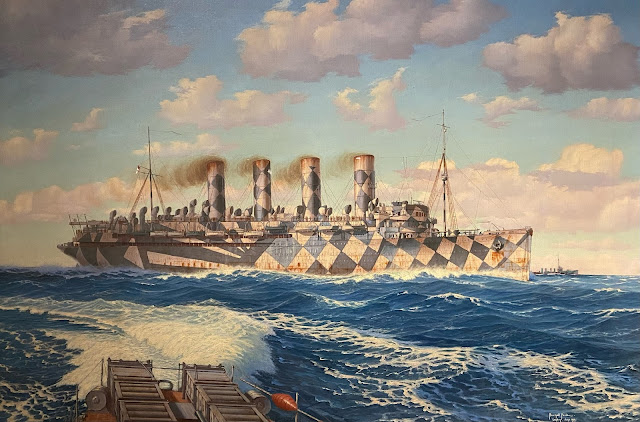 |
| A depiction of the Cunard liner RMS Mauretania (1906) in dazzle camouflage, painted by Burnell Poole in 1919. Requisitioned by the British government during the First World War, Mauretania was painted in dazzle camouflage in the later stages of the war. Mauretania transported troops during the Gallipoli campaign of 1916 and was later converted into a hospital ship to evacuate soldiers wounded in the fighting. Reverting back to a troop transport, Mauretania carried Canadian troops to France. After the war, the ship carried American and Canadian soldiers home from Europe until June 1919. Resuming commercial service in September 1919, Mauretania was withdrawn from service in September 1934, with the ship scrapped by 1937. |
 |
| The ship's bell from RMS Mauretania. Similar to a bell retrieved from the wreck of Mauretania's sistership, Lusitania, in 1982, this bell was made in 1907 by Thomas Utley and Company Ltd. of Liverpool. The company crafted bells for several liners, including Lusitania, Olympic, and Titanic. This bell was given to Bebington Parish, Wirral, in 1936 by Cunard Chairman Sir Percy Bates for use as its church bell. In 1989, the church council donated the bell to the Merseyside Maritime Museum. |
 |
| One section of the 'Lusitania: Life, Loss, Legacy' gallery, telling the story of the liner's construction and reputation for size, speed, comfort, and technology. When launched, Lusitania was the largest ship afloat and the first over 30,000 tons. Her sleek appearance and speed earned her the nickname 'Greyhound of the Seas', and Lusitania set a new westbound transatlantic crossing time during her second voyage on 11 October 1907, earning the coveted Blue Riband. |
 |
| A builder's exhibition model of the 19,566-ton Cunard liner RMS Carmania. Built by the John Brown & Co. shipyard in Glasgow and launched in February 1905, Carmania and sistership Caronia were the largest ships in Cunard's fleet at that time. Following the outbreak of the First World War, Carmania was requisitioned for the war effort and converted into an armed merchant cruiser. Commissioned as HMS Carmania, the ship's armament consisted of eight 4.7-inch Mk V naval guns. On 14 September 1914, Carmania engaged and sank the German auxiliary cruiser Cap Trafalgar near the Brazilian island of Trindade. Following repairs at Gibraltar, Carmania patrolled the Portuguese coast and took part in the disastrous Gallipoli campaign in 1916. Converted to a troop transport, Carmania carried Canadian troops home from Europe after the end of the war and subsequently resumed commercial service in 1919. Carmania was withdrawn from service in 1931 and sold for scrap in 1932. |
 |
| A display of artefacts from RMS Lusitania, including a deck stores key; a souvenir paper fan likely presented to a lady passenger at the Captain's Gala Night in the ballroom; a commemorative medal and medallion; a passenger's letter from the ship's maiden voyage; a pack of Lusitania playing cards; and a table place card. |
 |
| An 'Ormond' pattern soup plate manufactured by the Staffordshire pottery of Mintons in 1906 and used aboard Cunard's liners Lusitania and Mauretania. |
 |
| A dinner menu from RMS Lusitania for Thursday, 18 August 1910. The ship had departed New York the previous evening on her 88th transatlantic crossing. |
 |
| The gold pocket watch belonging to Lusitania's Captain William Turner. It was purchased from Penlington & Batty of St George's Crescent, Lord Street in Liverpool. |
 |
| A bed from Cabin C97 aboard the Cunard liner RMS Olympic, a sistership to the ill-fated Titanic. Cabin C97 was a First Class stateroom. During the First World War, Olympic was converted into a troop transport to accommodate 6,000 soldiers. While some of the servicemen who travelled aboard Olympic enjoyed luxurious staterooms like C97, which featured three beds, a mahogany wardrobe, electric lights, and comfortable bed linens, many others found themselves sleeping in tightly packed hammocks in basic living quarters below decks. |
 |
| One of Lusitania's wooden deckchairs, recovered from the sea by Irish fisherman Patrick O'Driscoll. O'Driscoll used the deckchair outside his cottage on Cape Clear Island, off the south coast of Ireland, until late in his life. |
 |
| On the top right are two Lusitania wine chits from the ship's final voyage, signed by passenger Charles Emelius Lauriat Jr., a bookseller from Boston, Massachussetts. While Lauriat boarded Lifeboat 7, when it proved impossible to launch, he jumped into the sea and was rescued by a fishing boat. At the bottom right is the boarding card belonging to Third Class passenger Margaret Ballantyne, who also survived Lusitania's sinking but never spoke of her experience. Ballantyne's Third Class ticket is on the left. |
 |
| A display case containing letters written by passengers and crew of the Lusitania, as well as a handwritten personal account of the ship's sinking by a Third Class passenger. |
 |
| A pair of cufflinks (#8) worn by Lusitania telegraphist Robert Leith on the day the liner was sunk, as well as the radio room key (#9) which he put in his pocket before abandoning ship. Leith worked for the Marconi Company and joined Lusitania in April 1915. The Royal Navy's warnings of lurking German submarines were received by Telegraphist Leith during Lusitania's final voyage and Leith sent SOS messages after the liner was torpedoed. He survived the sinking. |
 |
| The sole surviving complete lifejacket of this type from Lusitania's sinking. There were three types of lifejackets carried aboard the liner, with the other two types being placed over the head and secured at the waist. This type of lifejacket was wrapped around the body and secured with thin shoulder straps. After the sinking, Cunard offered cash rewards to local fishermen for retrieving bodies. This lifejacket's straps have been cut, suggesting that it was removed from a recovered body. A man from Cape Clear Island, off the southern coast of Ireland, kept this lifejacket as a souvenir. |
 |
| One of Lusitania's lifebuoys, made of cork and canvas. It was recovered by the captain of a fishing boat from Kinsale, Ireland, who assisted in the rescue efforts. The lifebuoy was given to a fish merchant who was in port at the time and was displayed for years in the merchant's office in Passage East, County Waterford. It is on long-term loan to the museum, courtesy of the merchant's grandson. |
 |
| A 1915 British military recruitment poster by Bernard Partridge, entitled 'Take up the Sword of Justice'. The poster was published a month after the sinking of Lusitania and depicts the figure of Justice rising from the sea and offering a sword as Lusitania sinks in the background. The imagery was meant to exploit the public outrage over the liner's sinking and to encourage people to avenge the sinking by enlisting in the British armed forces. The Lusitania disaster was used heavily in Britain and, later, in the United States to promote enlistment and support for the Allied war effort. |
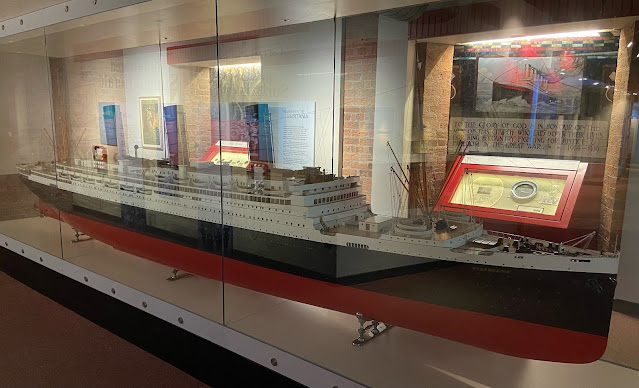 |
| A 1:50 scale builder's style model of the Cunard liner RMS Berengaria. Originally built in Germany in 1913 for the Hamburg-Amerika Line and named Imperator, the ship was intended to outclass Britain's great liners, such as Olympic, Titanic, Lusitania, and Mauretania. When launched, the 11-deck Imperator was the largest ship in the world, measuring 276 metres (906 feet) in length and 29.95 metres (98 feet 3 inches) wide. Following the First World War, Imperator was relinquished to Britain as part of Germany's reparations payments and bought by Cunard Line to replace the sunken Lusitania. Still named Imperator, the ship made her first voyage for Cunard from Liverpool to New York in February 1920. Renamed Berengaria in February 1921, the ship's homeport moved to Southampton for all subsequent voyages. Cunard operated the 52,117 gross ton Berengaria until 1938, after which she was retired from service and scrapped between 1939 and 1946. |
 |
| A First World War British propaganda poster exhorting Britons to save bread as a means of reducing food consumption and winning the war against the German submarines attacking merchant shipping importing such commodities as wheat. |
 |
| The entrance to the 'Battle of the Atlantic' gallery on the museum's first floor. A screen on the back wall plays footage shot from the bridge of the Town-class destroyer HMS Burnham while on convoy escort duty in the North Atlantic in 1944. The footage is taken from the British documentary film, 'Western Approaches', produced by the Crown Film Unit. |
 |
| A Mk IV depth charge thrower with a cutaway section of a Mk VII depth charge. The Mk IV thrower and Mk VII charge were standard anti-submarine weapons on Royal Navy escort ships during the Second World War. |
 |
| This room of the gallery tells the story of the development of the German submarine service and the U-boats' early successes during the war. |
 |
| A display recounting the growth of the German U-boat fleet, which began the Second World War with only 57 boats compared to the 300 estimated as necessary by Admiral Karl Dönitz, Commander of the U-boat service. Of these 57 boats, less than half had the range to operate in the Atlantic. Until early 1945, all of Germany's U-boats were based on First World War designs, with over half (704) being of the Type VII design. The 745 ton Type VII U-boat measured only 64.5 metres (218 feet) in length, making it manoeuvrable and difficult to locate either surfaced or submerged. With a range of over 6,437 kilometres (4,000 miles), the Type VII was well-suited to ocean-going operations and achieved remarkable success in the Atlantic campaign until mid-1943. Early successes by the U-boat fleet included the sinking of the SS Athenia on 3 September 1939 (93 passengers and 19 crew killed) and the old battleship HMS Royal Oak on 14 October 1939. Despite the limited number of U-boats available at any one time, faulty torpedoes, the withdrawal of some U-boats for operations in Norway, and restrictions placed on U-boat operations following the Athenia sinking, the U-boats sank over 200 British, Allied, and neutral merchant ships in the Atlantic by June 1940, averaging 22 per month. |
 |
| A display on life aboard the Flower class corvettes, small anti-submarine warfare vessels built at the start of the Second World War, which served as the backbone of the Allied escort forces during much of the Battle of the Atlantic. The Flower class corvette construction programme was ordered as a top priority by British Prime Minister Winston Churchill upon the outbreak of the war, with nearly 300 corvettes being built in Britain and Canada. The corvette was based on a commercial whalecatcher design and was cheap and easy to build in small shipyards. The first corvettes entered service in April 1940; they eventually sank a total of 38 German U-boats for the loss of just 25 of their own number. The display focuses on HMS Campanula, a corvette commissioned into the Royal Navy in 1940. Among Campanula's crew was author Nicholas Monsarrat, a young Lieutenant of the Royal Naval Volunteer Reserve (RNVR), who served aboard the ship between 1940 and early 1942. Campanula served as the inspiration for Monsarrat's 1942 book HM Corvette and his later best-selling 1951 novel, The Cruel Sea. Campanula was based at Liverpool's Albert Dock in February 1941. The anti-submarine escort vessels in the Battle of the Atlantic were manned largely by wartime or 'hostilities only' sailors, whether conscripts, volunteers, or naval reservists. The display case contains Nicholas Monsarrat's medals; a copy of The Cruel Sea; a steel helmet and pair of woollen mittens worn by Campanula's Liverpool-born captain, Lieutenant-Commander Richard Case; and a shell casing from Campanula's 2-pounder anti-aircraft gun. At the bottom of the display case is a 1:96 scale model of the Flower class corvette HMS Picotee, which entered service in September 1940 and was based at Greenock, Scotland. In August 1941, Picotee was torpedoed and sunk with the loss of all hands by U-568 off southern Iceland while escorting convoy ON 5. |
 |
| A display on the 'Bismarck action' of May 1941 and the role of the Royal Navy's Fleet Air Arm in the sinking of the 42,000 ton German battleship. Twenty-six Fleet Air Arm aircraft, mostly obsolete Fairey Swordfish biplanes flying from the carriers HMS Victorious and Ark Royal, and 78 airmen took part in shadowing or attacking Bismarck during her sortie into the North Atlantic. On the evening of 26 May, a torpedo dropped by a Swordfish from Ark Royal struck Bismarck, critically damaging the battleship's rudder and effectively sealing her fate at the hands of pursuing Royal Navy ships. The display tells the story of the genesis and intent of Bismarck's voyage, her sinking of the British battlecruiser HMS Hood, and the subsequent hunt and sinking of Bismarck by British forces. Items displayed include an identity tag worn by Friedrich Junghans, one of the Bismarck survivors rescued by HMS Dorsetshire; A Royal Navy rating's cap; a gunner's flash hood; pre-war tea and jam spoons sold as souvenirs of HMS Hood; Royal Navy issue binoculars in a case stamped 'HMS Hood' and dated 1940-41; a cap tally from the German heavy cruiser Prinz Eugen, which accompanied Bismarck on her breakout into the North Atlantic; and small waterline models of some of the ships that took part in the action. |
 |
| A splinter from one of the 15-inch shells fired by the German battleship Bismarck which straddled the British battleship HMS Rodney during Bismark's final action on 27 May 1941. |
 |
| The ship's bell from the battleship HMS Rodney (1927-1948), alongside a 1:600 scale waterline model of Rodney. The 34,000 ton Nelson-class battleship was built by Cammell Laird Ltd. of Birkenhead and played a major role in the sinking of the German battleship Bismarck on 27 May 1941. For over an hour, Rodney's 16-inch guns and the 14-inch guns of the battleship King George V pounded Bismarck until she was reduced to a blazing wreck. Bismarck finally rolled over and sank after being torpedoed by the cruiser Dorsetshire, with the sinking expedited as a result of Bismarck's crew detonating scuttling charges and opening watertight doors within the ship to hasten flooding. Only 118 of the German vessel's crew of over 2,200 were saved after the sinking. |
 |
| A 'Mackworth' fog buoy in a display on anti-submarine warfare. The 'Mackworth' fog buoy was used by Atlantic convoy vessels during thick fog to help prevent the ships behind from coming too close. When towed from the stern of a ship, they scooped up small water 'fountains' which could be seen from the ship directly behind the towing vessel. |
 |
| A large model of the German battleship Tirpitz, launched in April 1939 and commissioned into the Kriegsmarine (Nazi German navy) in February 1941. The 49,900 ton battleship measured 241.6 metres (792 feet 8 inches) overall, with a beam of 36 metres (118 feet 1 inch) and a main armament of eight 15-inch guns in four twin turrets. In January 1942, Tirpitz was stationed in Norway to serve as a deterrent against an Allied invasion, to tie down Allied naval forces at the British base at Scapa Flow in the Orkneys, and to intercept Allied convoys carrying war supplies to the Soviet Union. Tirpitz saw little action, however, firing her main battery only once, during a bombardment of Allied positions on the island of Spitzbergen in September 1943. On 22 September 1943, Tirpitz was damaged at her Norwegian moorings by British midget submarines and between April and October 1944 was attacked by several large scale British air raids. On 12 November 1944, Tirpitz was finally sunk by British Lancaster heavy bombers which dropped 12,000 pound Tallboy bombs on the battleship, causing her to capsize. An explosion in one the main battery turrets killed an estimated 950-1,204 of the crew. The wreck of the Tirpitz was broken up by a Norwegian-German joint operation between 1948 and 1957. |
 |
| A 1:96 scale model of SS Malabar, a cargo steamer owned by the Liverpool-based Brocklebank Line. Built in 1938 and originally named Martand, in October 1939 Malabar was part of convoy HX 5, sailing from Halifax, Nova Scotia to Britain. Carrying tobacco, timber, and general cargo for London and Avonmouth, Malabar left the convoy to take the southern route around Ireland in company with an oil tanker and the destroyer HMS Grafton. In the early hours of 29 October, Malabar was torpedoed by German submarine U-34 while 80 kilometres west of the Scilly Isles, off the southwest tip of Cornwall; she sank the following afternoon. Five members of Malabar's crew of 81 were killed. Malabar's sinking came at a time when German U-boats were singling out Atlantic convoys for attack, especially during the critical point at which the convoy's merchant vessels separated west of Ireland in order to sail to different ports. These small groups were escorted only by a single destroyer, which provided an inadequate defence against the stealthy U-boats. |
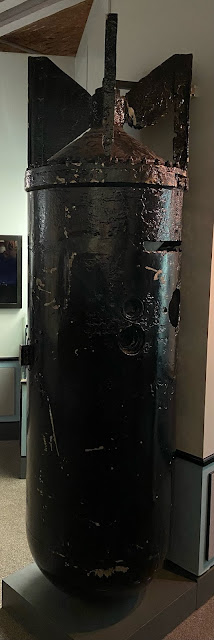 |
| A German ground mine, 1939-1945. These ground mines were originally designed as a magnetic mine for use against ships and dropped either by aircraft (using a parachute) or by surface vessels. At the start of the Second World War, the ground mine was one of Germany's most secret weapons and it was later modified to explode in response to noise, to a time fuze, or to water pressure. The ground mine displayed in the museum is made of aluminum alloy and carried 1,536 pounds (697 kilograms) of hexanite, a high explosive. The Germans also used these ground mines as bombs, dropping many on London, Liverpool, and other British cities. |
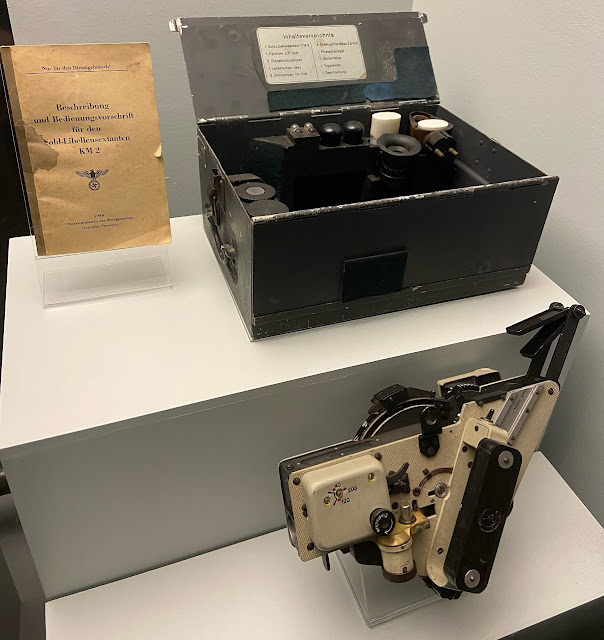 |
| A Sold Libellensextant KM2 bubble sextant, with box and instructions manual, circa 1939-45. This sextant was one of several models specially manufactured by the Plath firm of Hamburg for use on U-boats. It was acquired by Commander P.C.E. Richardson of the Royal Navy in May 1945 after surrendered U-boats were escorted to various Allied bases, including Lishally in Northern Ireland, where Richardson was posted. On 14 May 1945, a surrender ceremony was held at Lishally following the arrival of the first flotilla of surrendered U-boats. Admiral Sir Max Horton, Commander of Western Approaches Command in Liverpool, flew in for the ceremony. Eventually, approximately 60 U-boats were surrendered at Lishally and these were towed out to sea and sunk by gunfire, torpedo, or bomb as part of Operation Deadlight. This sextant was likely acquired by Commander Richardson from one of these U-boats prior to its final voyage. |
 |
| A display of German U-boat medals. At the top is an Iron Cross, Second Class (1939-1945), an award given to large numbers of U-boat crewmen. At bottom is a U-boat patrol badge (1939-1945), awarded to U-boat officers and crewmen who completed three or more missions against the enemy during the war. The 40,000 officers and men of the U-boat fleet were lavishly awarded medals to help sustain morale in the face of unpleasant onboard conditions, extreme danger, and crippling losses inflicted by Allied anti-submarine forces. |
 |
| A full-scale replica of the 'viewing end' of a U-boat attack periscope. Visitors who look through the eyepiece see a photo of an Allied convoy of merchant ships on the horizon. |
 |
| A circa 1941 German navy recruiting poster exploiting the glamour of the U-boat fleet and its successes in the early years of the war. |
 |
| A display case containing a pair of heavy, brass binoculars carried aboard German U-boats and clipped to the top of a torpedo-aiming device on the conning tower during surface patrols. Bearings from the device were automatically transmitted to crewmen in the U-boat's torpedo room. Behind the binoculars are various Second World War German navy badges, including a national eagle breast badge (#1); an officer's cap cockade (#2); a Radio Telegraphist's sleeve badge (#3); an Ordnance officer's sleeve badge (#4); and a Gunnery officer's sleeve badge (#5). |
 |
| The room in the exhibit devoted to the story of the British Merchant Navy. In 1939, Britain's population of 48 million people depended for their survival on maritime trade, which was carried in the world's largest merchant fleet, comprising 1,900 ocean-going merchant ships manned by crews from throughout the Commonwealth. During the war, these ships and crews, supplemented by the ships and crews of friendly nations, brought to Britain all of the oil, half the food, and most of the raw materials required to maintain the war effort. They also exported manufactured goods to help pay for these critical imports. |
 |
| A display on life at sea aboard a wartime merchant ship, combining the daily routine of watches, off duty time spent sleeping and playing cards, and the terror of attacks by German U-boats. As noted, engine room personnel were more vulnerable during attacks, since the engine room was a prime target for U-boat torpedoes and escape from the bowels of the ship was difficult. Ships carrying heavy cargoes, such as iron ore, were prone to sinking rapidly after being torpedoed, while oil tankers often exploded in a fireball that incinerated their crews. Items in the display case include a water-dipper used to measure water rations, taken from one of the lifeboats of the SS Calchas, torpedoed and sunk off South Africa in March 1941; a tin of emergency food rations stowed on a lifeboat aboard the corvette HMS Abelia in 1943; a 'Mae West' style lifejacket used by Allied seamen during the war; an emergency spark transmitter used to signal to other ships; an all-weather protective suit of the kind issued to over 200,000 British merchant seamen during the war; a duffel coat worn by Allied naval and merchant sailors on Atlantic convoys; and the commissioning pennant of the Liverpool-based destroyer HMS Hesperus. |
 |
| A 1:96 scale model of the 7,200 gross ton Liberty ship SS Samarina, launched in September 1943. Built by the Bethlehem-Fairfield Company of Baltimore, USA, Samarina was one of several Liberty ships transferred to the British Ministry of War Transport by the US government. The ship carried valuable war cargoes throughout the final two years of the war. The Liberty ship design was based on that of a British tramp steamer and was considered an 'ugly duckling' but quick and easy to build in large numbers. Samarina and the other Liberty ships had good anti-aircraft armament and their bridges were shielded by 'plastic armour', a British invention. |
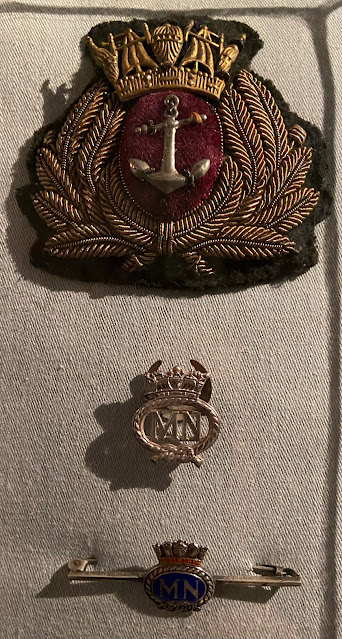 |
| Merchant Navy uniform items, including an officer's cap badge (top); a buttonhole badge (middle); and a tiepin (bottom). Until 1939, the terms 'Merchant Service' or 'Mercantile Marine' were commonly used; however, during the Second World War, the term 'Merchant Navy' entered widespread usage, influenced by the issue of the Merchant Navy buttonhole badge, which was voluntarily worn by merchant seamen from January 1940. |
 |
| A display on the role of passenger liners during the Second World War, when many were requisitioned by the British government and converted into troopships and hospital ships. After the war, many surviving passenger liners returned Allied troops home and carried war brides to be reunited with their servicemen husbands in North America, Australia, and New Zealand. |
 |
| A 1:96 scale model of His Majesty's Hospital Ship Atlantis, constructed by medical orderlies posted aboard the ship. Built as a 15,000 ton cruise liner for the Royal Mail Steam Packet Company and originally named Andes, Atlantis was converted into a hospital ship in 1939. After her conversion, Atlantis was able to carry up to 615 patients and a medical staff of 130, including many female nurses provided by the Royal Army Medical Corps. Crewed by merchant sailors of the Royal Mail Lines, Atlantis served throughout the war and was constantly engaged in missions of mercy. She docked at Liverpool several times during the war. Atlantis was bombed twice off Norway, steamed a total of 280,000 miles, and carried 35,000 wounded from numerous war zones. After the war, Atlantis repatriated prisoners of many nationalities and carried war brides to Australia before being returned to commercial service in 1946. |
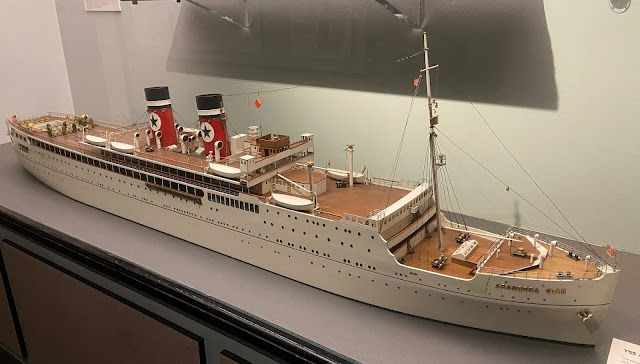 |
| A 1:96 scale model of the Twin Screw Ship (TSS) Arandora Star, a Blue Star Line passenger liner requisitioned by the British government in early 1940 and converted into a troopship. On 2 July 1940, Arandora Star sailed from Liverpool carrying over 400 German and 700 Italian civilian internees and 86 German prisoners of war, as well as over 200 guards. The ship was bound for Canada as the British government feared a Nazi invasion after the fall of France and did not want to risk the internees being freed by the German invaders. At 06:15 on 3 July, Arandora Star was torpedoed by the German submarine U-47 while steaming westward 120 kilometres (75 miles) off the northwest coast of Ireland. The ship sank in an hour, with only 868 of the more than 1,600 people onboard surviving, including 586 internees. A shortage of lifeboats, the lack of a lifeboat drill after leaving Liverpool, and the use of barbed wire around the boat deck contributed to the high death toll. A large number of the Italian internees died in the sinking, given that many were middle aged or elderly and accommodated in the lowest deck and therefore unable to escape. Those German and Italian internees that did survive the sinking of Arandora Star were put aboard another ship in Liverpool and sent to Canada; however, the loss of the Arandora Star led the British government to cease civilian deportations and change internment policy. |

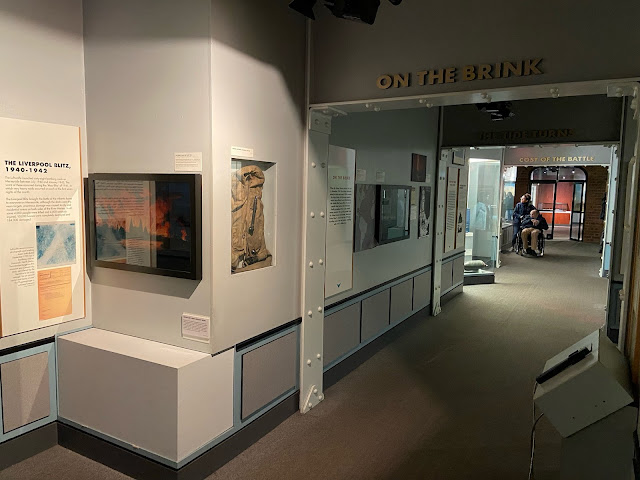 |
| This room of the gallery includes information on the 'Liverpool Blitz', the German air attacks on Merseyside between July 1940 and January 1942. As Britain's most important port during the war, handling at least one-third of the nation's imports, Liverpool was the main British terminus for the Atlantic merchant convoys. A total of 1,285 convoys and 76,000 ships arrived in the Mersey during the war, averaging four convoys and 280 ships (not all in convoy) per week. By early 1941, Liverpool was also a major naval base and the headquarters of Western Approaches Command, the combined headquarters responsible for managing the Battle of the Atlantic. As such, the Luftwaffe (Nazi German air force) devoted special attention to Merseyside, carrying out 68 bombing raids, more than any other British port apart from London. The worst of these air attacks occurred in May 1941, when heavy raids were carried out on each of the first seven nights of the month. The Luftwaffe targeted the docks along the Mersey, but the inherent inaccuracy of aerial bombing meant that significant damage was also caused to the city of Liverpool and residential districts on both sides of the river. Approximately 4,000 people were killed and another 4,000 seriously injured, while 10,000 homes were completely destroyed and 184,000 others damaged. |
 |
| A German Luftwaffe lifejacket (1939-45). |
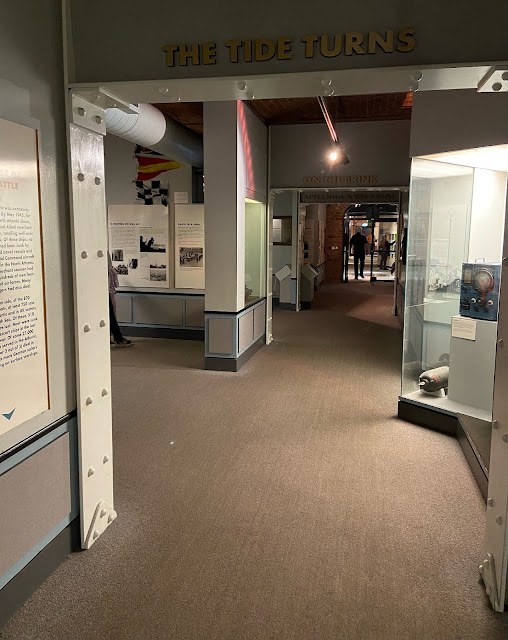 |
| The Battle of the Atlantic gallery comprises several interconnected rooms, each telling the story of a different aspect of the war, including this section on the Allied success in gaining the upper hand against the U-boats through a combination of tactical and technical superiority, superb intelligence, and the growing number of Allied anti-submarine warfare forces, both at sea and in the air. |
 |
| A bomb from a Hedgehog mortar. Hedgehog mortars were carried aboard many Allied anti-submarine escort vessels. When a submarine contact was established ahead of the escort vessel, 24 of the contact-fuzed bombs were fired at once. If they struck a submerged submarine, the bomb would explode, hopefully rupturing the pressure hull of the enemy vessel and causing it to either sink or surface. |
 |
| A High-Frequency/Direction-Finding (HF/DF) transducer of the type installed on British escort ships in the Atlantic during the war. Nicknamed 'Huffduff', HF/DF was a British invention that allowed anti-submarine escort vessels to determine the bearing or direction of a U-boat by detecting its high-frequency (short wave) radio emissions. While HF/DF only established the bearing and not the range of an enemy vessel, a skilled HF/DF operator could make a roughly accurate estimate of the U-boat's position. After 10-centimetre radar, HF/DF was probably the invention that contributed most to Allied victory in the Atlantic theatre. Together, radar and HF/DF deterred U-boats from attacking convoys, thereby allowing the escort forces to achieve their objective of ensuring the safe and timely arrival of the merchant ships under their watch. |
 |
| A British Mk VIII torpedo. Measuring 6.7 metres (22 feet) in length, the Mk VIII was the Royal Navy's standard submarine torpedo during the Second World War. Propelled by an engine fuelled by compressed air and shale oil, the Mk VIII was similar in size and design to torpedoes used by German U-boats at the start of the war. However, the Germans soon developed electrically-driven torpedoes which left no trail of bubbles in their wake and were therefore more difficult to detect and evade. The highly reliable and effective Mk VIII torpedo had a maximum speed of 45 knots (83 km/h, 52 mph) and an effective range of 400-2,000 yards (366-1,829 metres). |
 |
| A 1:96 scale model of HMS Starling, a modified Black Swan class sloop of the Royal Navy built in 1943 by Fairfield Shipbuilding & Engineering of Govan, Scotland. Starling was commanded by the famous Captain Frederic 'Johnnie' Walker (1896-1944), the most successful anti-submarine warfare commander in the Battle of the Atlantic. Upon taking command of Starling in March 1943, Walker brought with him many of the crew from his previous ship, HMS Stork. Starling, like the other sloops of her class, were designed as anti-submarine vessels, being fast, well-armed, and highly manoeuvrable. Western Approaches Command's 2nd Support Group of six sloops, commanded by Walker, was free to hunt down U-boats wherever they were detected. The Group eventually sank 15 U-boats, with HMS Starling being directly involved in sinking 11 of these. After Walker's death from a stroke on 9 July 1944 at the age of 48, the 2nd Support Group went on to sink an additional four U-boats, making it the Royal Navy's most successful anti-U-boat ship of the war. In the post-war period, Starling served for many years as a Navigation School tender at Portsmouth, after which she was scrapped in 1965. HMS Starling measured 91.3 metres (299.5 feet) in length, with a beam of 11.7 metres (38.5 feet) and a draught of 2.7 metres (9 feet). Displacing 1,350 tons, Starling's Parsons geared steam turbine engines gave her a maximum speed of 20 knots (37 km/h, 23 mph). Starling's armament consisted of six 4-inch dual purpose guns, two twin 40mm Bofors guns, and Hedgehog Mark II anti-submarine mortars, as well as eight depth charge throwers and two depth charge rails with 110 depth charges carried aboard. Her complement was 181 officers and ratings. |
 |
| A 1:192 scale model of the SS Marwarri, a cargo liner of 8,000 gross tons built in 1935 for the shipping company of T&J Brocklebank Ltd. of Liverpool. Shortly after the outbreak of war in 1939, Marwarri and all other British cargo liners were requisitioned by the UK government. Marwarri served as a cargo vessel and later transported both troops and equipment to support the Allied liberation of Axis-occupied Europe. The model depicts Marwarri in her wartime grey livery after a refit that saw the installation of a new propeller and anti-aircraft guns in preparation for her role in the Normandy landings on 6 June 1944. Between June and August of that year, Marwarri made seven round trips to the Normandy beaches, delivering thousands of troops and vehicles for the invasion. |
 |
| An undated oil painting by artist Norman Wilkinson entitled 'HM Troopship Queen Mary at the Clyde Anchorage'. Although large numbers of troops and military supplies arrived and departed from Liverpool and other ports on the west coast of Britain during the Second World War, the largest troopships, Queen Mary and Queen Elizabeth, always used the Clyde Anchorage off Greenock in Scotland. This anchorage was Britain's main 'trooping port' during the war. |
 |
| At the entrance to the 'Lifelines' gallery is a series of life-sized statues of various seagoing occupations from the 19th and 20th centuries. From left to right: a First Mate of a merchant ship in the 1860s, a shipboard Stewardess in 1950, a ship's Master in 2000, an Ordinary Seaman in 1910, and a Fireman in 1900. |
 |
| A 1:64 scale exhibition model of the Twin-screw Steamship (TSS) Media, a passenger and cargo liner built by John Brown and Company of Clydebank for the Cunard Line and launched on 12 December 1946. Media was the first ship built for Cunard after the Second World War and departed on her maiden voyage from Liverpool to New York on 20 August 1947, carrying First Class passengers only. Despite the resurgence of tourist travel in the post-war period, the accessibility of safe and affordable air travel meant that by the 1960s more passengers were crossing the Atlantic by aircraft than by ship. Suffering a drop of 30,000 transatlantic passengers from the previous year, in 1961 Cunard sold both Media and her sistership Parthia after less than 15 years of service. Media's last voyage in Cunard service was between Liverpool and Quebec City on 14 October 1961. The ship was sold to an Italian company and renamed Flavia, sailing on the Genoa-Suez-Australia route. In the late 1960s, Flavia was sold to another Italian company and used for cruises out of Miami. Purchased by the Flavian Shipping Company in 1982, the ship was re-named Flavian and re-registered in Panama. Sold again in 1986 and re-named Lavia, the ship sailed to Hong Kong and, after a period laid up, is believed to have been scrapped there. |
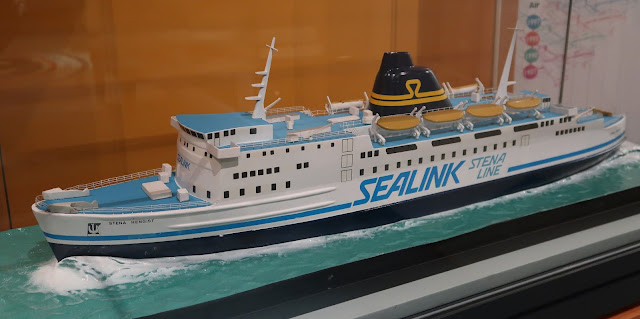 |
| A model of the 5,590 gross ton roll-on/roll-off ferry MV Stena Hengist. Built in 1972 at the DCNS Arsenal de la Marine Shipyards in France for the Stena Line, Stena Hengist operated in the English Channel on the Folkestone-Boulogne route until 1991. Passing through various owners thereafter, in 2004 the ship ended up in service with Vaggelis Ventouris and was re-named MV Panagia Tinou to serve the Greek Islands. In April 2016, Panagia Tinou sank at her dock in Piraeus, Greece. After being refloated in February 2017, the ship was scrapped in Aliağa, Turkey later that year. The model of Stena Hengist is part of a display on cross-channel ferries, which in 1997 (the date of the display) carried 32 million passengers between the UK and Continental European destinations, as well as four million to and from the Republic of Ireland. Ferries can compete with air travel and the Eurostar train service on these short routes because they carry large numbers of vehicles and foot passengers to a wider range of destinations. Roll-on/roll-off ferries like Stena Hengist were introduced on routes to and from Britain in the mid-1960s in response to the growth of road traffic at that time. |
 |
| A 1:100 scale exhibition model of the container ship SS Liverpool Bay. Built in 1971 by Germany's Howaldtsewerke-Deutsche Weft AG for Overseas Containers Limited (OCL), Liverpool Bay measured 289.55 metres (950 feet) in length, with a beam of 32.26 metres (105.8 feet) and a draught of 24.60 metres (80.7 feet). The 56,000 gross ton ship could carry over 2,300 containers. Her two 40,500 shaft horsepower turbine engines gave a speed of 27 knots (50 km/h, 31 mph). Liverpool Bay was one of five container ships built for OCL in 1971 and was one of the first ships to use computer technology to coordinate the complex requirements of organising containers to ensure correct weight distribution. Although container ships could carry vast amounts of cargo and required far fewer crew to operate, their size meant they were much more expensive to build that previous cargo vessels. To compete internationally in the new era of containerisation, OCL was formed by four British shipping companies. |
 |
| The 'Lifelines' gallery highlights the role of merchant ships and seafarers in providing a vital lifeline for Britain through the carriage of passengers and goods in peace and in war over the last 300 years. |
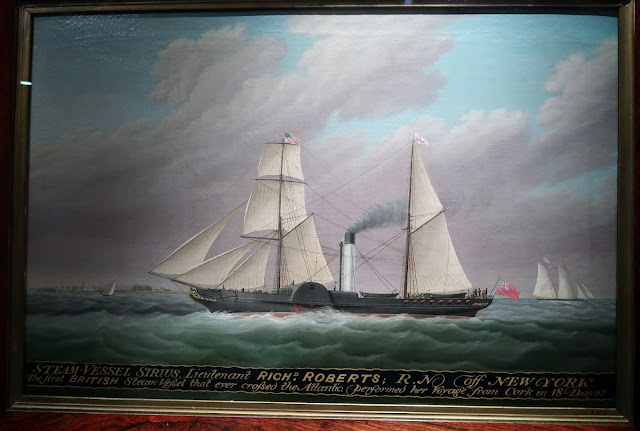 |
| An oil painting of the wooden paddle steamer Sirius, depicted off New York on 22 April 1838 after achieving the record of being the first vessel to cross the Atlantic using steam power alone. Sirius's voyage from Cork, Ireland took 18.5 days, during which the ship used her entire inventory of coal during the stormy crossing. Sirius arrived in New York just hours before her larger rival, the SS Great Western. The small Sirius had originally been built for the coastal trade between Cork and London and, on the voyage to New York, her captain had to convince his crew not to turn back due to the bad weather. For this voyage to America, Sirius carried 40 passengers (29 men and 11 women) in three classes, with canned salmon, oysters, and lobsters being among the provisions served during the trip. |
 |
| This section of the 'Lifelines' gallery is devoted to ocean passenger voyages and the many Liverpool-based shipping companies that operated steamships to many far-flung and exotic destinations. While most passengers travelling by sea did so aboard sailing ships until the 1860s, from 1870 steamships were carrying more and more passengers and doing so faster, cheaper, and more comfortably. Whereas it took the Cunard Line's wooden paddle steamer Britannia 14 days to cross the Atlantic in 1840, the company's RMS Queen Mary, five times the length of Britannia and nearly 70 times larger in tonnage, made the crossing in only four days in 1936. |
 |
| A circa 1931 poster for Booth Line's routes to Portugal, Maderia, and North Brazil, including cruises 1,000 miles up the Amazon River. |
 |
| A display describing the shift in sea travel during the period of the 1950s to the 1990s. Items displayed here include a 1950s coffee cup and saucer from the Isle of Man Steam Packet Company; cocktail swizzle sticks from Canadian Pacific Steamship Lines passenger liners in the 1950s; a red plastic holdall purchased aboard the Shaw Savill passenger ship MV Southern Cross on a 1961 voyage from Southampton to Cape Town; and a selection of material from 1990s passenger ferries, including sea sickness bags, magazines, and an ashtray. |
 |
| A display of tableware used aboard the Cunard liner RMS Queen Mary. Much of this tableware was manufactured by Stoniers Ltd. of Liverpool, which supplied fine china and tableware to major British shipping companies for more than a century. Queen Mary was the first British liner to embrace the Art Deco style embodied in the ivory coloured earthenware service seen on the left, with its bands of golden brown, grey, and black. In the centre is a bone china table service with a pink rose pattern. The display contains several examples of the iconic cube-shaped crockery used aboard Cunard ships, manufactured by the Cube Teapot Company of Leicester. These designs were still in use on the Queen Elizabeth 2 as late as 1968, though the patterns and manufacturers changed over the years. Queen Mary had a separate kosher pantry and kitchen to cater for Jewish passengers, as well as special kosher crockery. |
 |
| A breakfast menu from Cunard's Queen Mary, showing the wide range of hot and cold items available to passengers. |
 |
| A display of White Star Line crockery dating from 1900-1914. Items include a side plate, sugar bowl, and coffee cup and saucer. |
 |
| More White Star Line crockery, featuring a floral pattern or blue/white pattern. Items include side plates, a kidney-shaped dish, an egg cup, and a teacup and saucer. |
 |
| A display of tableware from various British steamship lines of the 19th and early 20th centuries. Items include plates, a cream jug, a condiment set, a kettle, various forks and knives, a sugar basin, a coffee pot, a silver candlestick, and a wine funnel. The large blue and white platter in the centre of the display is a meat dish used aboard SS Great Britain in the 1860s. |
 |
| A souvenir metal box depicting Cunard Line's RMS Queen Mary (1934) of 81,237 tons. |
 |
| An oil painting by Robert Dodd (1748-1815), entitled 'An East India-man taking a pilot of Dover'. Until the early 1800s, all British trade with India and China was controlled by the East India Company, founded in 1600. The company generated huge wealth for its investors and was largely responsible for the British conquest of India. So powerful was the East India Company that the British government allowed it to rule India; however, the company's monopoly on trade to India ended in 1813, while its control over the China trade ended in 1833. The East India Company was dissolved in 1858. The company's ships were amongst the finest and largest vessels of their time, returning to Britain with exotic cargoes of tea, silk, spices, porcelain, sugar, and rice. They also carried passengers, mainly British military and government officials, between London and India. |
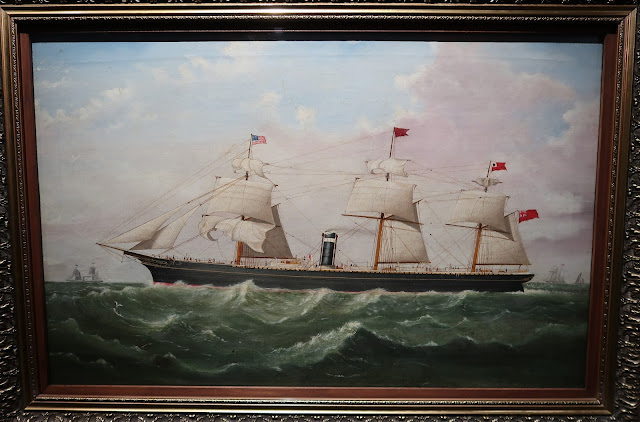 |
| An oil painting of City of Paris, 1874. This ship, built in 1865 for the Inman Line, operated on the transatlantic service from Liverpool to New York. City of Paris was one of a large number of Inman Line ships active in the emigrant trade. The red swallowtail pennant depicted flying from the main mast likely suggests that the ship was also carrying mail. |
 |
| The uniform of Chief Engineer George Linford, who served aboard the 4,718 gross ton SS Daldorch, owned by the shipping company of JM Campbell & Son of Glasgow, around 1930. |
 |
| A builder's model of RMS Empress of France, built by John Brown and Company of Scotland for the Canadian Pacific Steamship Company in 1928. The 20,123 gross ton liner was originally named Duchess of Bedford and was one of a class of four Canadian Pacific steamships designed for the Liverpool-Montreal route. She set new standards for comfort, including being fitted with hot and cold running water in all cabins. Duchess of Bedford measured 183.2 metres (601 feet) in length, with a beam of 22.9 metres (75 feet). Two steam turbines driving twin screws provided a top speed of 18 knots (33.3 km/h, 20.7 mph). As built, the ship had a capacity of 1,570 passengers in three classes; this was reduced to 441 First Class and 259 Tourist Class passengers following her 1947 refit. A second refit, in 1958-59, saw the re-named Empress of France's passenger capacity amended to 218 First Class and 482 Tourist Class. The ship's crew numbered 510. |
 |
| Requisitioned by the Royal Navy in September 1939, Duchess of Bedford served as a troopship during the Second World War, transporting 179,000 personnel and steaming over 400,000 miles. The ship was even credited with sinking a German U-boat in August 1942. Duchess of Bedford was renamed Empress of France in October 1947 during a major refit preceding Canadian Pacific's re-establishment of the Liverpool-Montreal service in September 1948. Withdrawn from service in 1960, Empress of France was scrapped at Newport, Wales at the end of the year. |
 |
| A display made up to resemble a shipping container tells the history of containerisation, an innovation of the 1960s that revolutionised the shipping industry. With goods packed in shipping containers that are easily handled and transferred to and from flatbed trucks or rail cars, cargo ships are able to spend much less time in port and the number of dockside workers required to handle cargo has fallen dramatically. Stowing goods on board ship has always been a crucial skill to ensure the vessel remains stable during loading and at sea. While a ship's officers previously relied on their own experience, manuals, and mechanical devices to calculate the safe distribution of cargo, today's modern ships are equipped with computers that calculate and direct the appropriate loading of cargo. |
 |
| A scale model of the steam coaster Clara Monks, operated by the shipping company JH Monks Ltd. The 577 gross ton Clara Monks was built in 1920 by the Ailsa Shipbuilding Company in Troon, Scotland. She was 51.9 metres (170.3 feet) in length and powered by a triple expansion steam reciprocating engine generating a speed of 10 knots (18.5 km/h, 11.5 mph). Clara Monks was broken up in 1960. Coasters were designed to carry bulk and general cargoes in coastal waters. |
 |
| A 1:100 exhibition model of Offshore Accommodation Platform AV-1. Built by Cammell Laird Shipbuilders Ltd. of Birkenhead for British Gas, this self-elevating or 'jack-up' accommodation platform was constructed in 1985 for use in the Morcambe Bay Gas Field off northwest England. The platform had four 88-metre (288.7 foot) legs with a hydraulic jacking system that allowed it to operate in tidal waters to a maximum depth of 47.5 metres (155.8 feet). The platform's six decks could accommodate up to 350 staff and featured a helicopter landing deck, storage areas, a workshop, a cinema, and a gym. The large 'crawler' crane could lift up to 50 tonnes over a radius of 50 metres (164 feet). A gangway was also carried to permit access to an adjacent structure, such as a gas or oil rig. |
 |
| The figurehead from HMS Hastings, built in 1818 in Calcutta for the East India Company and acquired by the Royal Navy the next year. It depicts Lord Hastings, Governor General of India at the time of the ship's construction and the ship's namesake. The figurehead is typical of the type found on British naval ships in the early 19th century and was likely made in England and fitted to the ship upon her arrival in the UK in 1819. HMS Hastings was a 74-gun (third rate) warship and saw service in the waters off Syria and Burma. In 1855, she was converted to screw propulsion and joined the Royal Navy's Baltic fleet. Arriving in Liverpool as a coastal defence vessel in 1857, HMS Hastings was sold as a hulk in 1886 and subsequently broken up. This figurehead was presented to the CW Kellock & Company shipbrokers and was displayed in the company's Liverpool showroom for many years before being donated to the museum. |
 |
| An octant in a protective wooden box. Octants are reflecting instruments used for celestial navigation at sea. The instrument's arc is one-eighth of a circle. |
 |
| A display on cadet training schools that fed the British Merchant Navy's demand for crewmen during the 19th and early 20th centuries. The Training Ship (TS) Indefatigable, one of these sea training schools, opened in Liverpool in 1865 for boys intending to become deck crew in the Merchant Navy. The school was originally based aboard the retired 50-gun frigate HMS Indefatigable, moored in the River Mersey. The school moved ashore during the Second World War and closed at the end of the 1995 term due to declining student numbers. The display case contains a TS Indefatigable cadet's uniform; a terracotta bust of an Indefatigable cadet, 1896; a Certificate of Character from the Industrial Training Ship Clio off Bangor, North Wales; and a Certificate of Discharge from TS Indefatigable. |
 |
| The entrance to the 'Life on Board' gallery, which profiles a variety of men and women who have made their careers at sea over the decades, as well as showcases the passenger experience aboard ship, from the era of the great transatlantic liners to the modern cruise ship. |
 |
| These large brass letters were once installed on the stern of Lusitania's sistership, RMS Mauretania, launched in 1907. Liverpool was the port of registry for Cunard liners and these letters appeared under the ship's name. Once the biggest and fastest liner in the world, Mauretania was scrapped in 1935. |
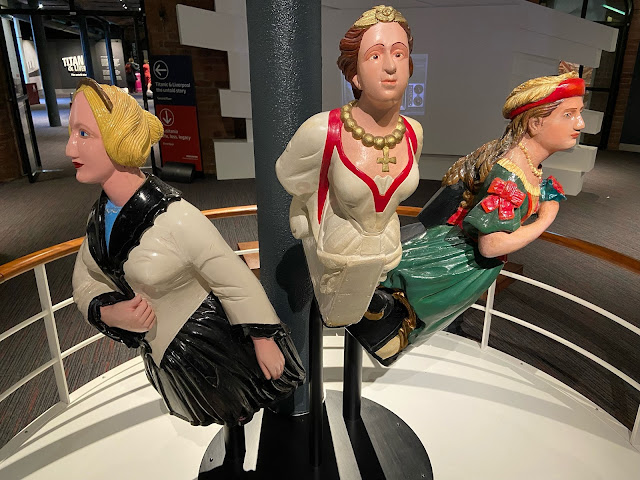 |
| Three ship's figureheads displayed in the 'Life on Board' gallery. On the left is the figurehead from the wooden barque Lottie Sleigh, built in 1852 on Prince Edward Island in Canada for the firm of Hatton and Cookson of Liverpool. In the centre is the figurehead from another Prince Edward Island-built ship, the two-masted wooden schooner Beatrice, built in 1860. On the right is the figurehead from the iron schooner Rosebud, built around 1865. |
 |
| Three of the Merseyside Maritime Museum's extensive collection of over 2,000 ship models. Shown here from top to bottom are TSS Cedric (1903), RMS Aquitania (1913), and RMS Queen Elizabeth (1938). |
 |
| A model of the 1,150 gross ton paddle steamer RMS Britannia, built for the British and North American Royal Mail Steam Packet Company (later known as the Cunard Line) in 1840. Britannia and her three sisterships, were the first ocean liners built for Cunard and established the first year-round Atlantic steamship service. |
 |
| The 'Life on Board' gallery contains an eclectic mix of artefacts and displays. On the far left of this photo is a display case containing the uniform of Captain Belinda Bennett of Windstar Cruises, the first black woman to serve as captain of a cruise ship. Also displayed are a 1901 portrait of an unknown sea captain by WH Walton and a pair of binoculars awarded to Captain Edward William Freeman by the King of Norway in 1902 after saving the crew of a Norwegian ship in distress. |
 |
| From left to right: a brass binnacle and compass dating from circa 1915; a ship's wheel from circa 1969; and a telegraph bridge transmitter from a Bank Line vessel of the 1960s and 1970s. |
 |
| One of the seafarer profiles in the 'Life on Board' gallery is devoted to Lady Assistant Purser Lynn Littler, who served aboard Cunard's RMS Queen Elizabeth from the age of 21. Her duties included typing, passenger enquiries, stenography, onward travel arrangements, and preparing manifests. Ms. Littler also served aboard Cunard ships Queen Mary, Franconia, and Queen Elizabeth 2, working her way up to the position of Captain's Secretary and eventually being appointed Social Directress, responsible for all aspects of QE2's entertainment programme. The display contains Ms. Littler's clothes brush from RMS Franconia (#3), her Purser/Hotel Officer's cap (#4), and her Cunard badges (#5). Also displayed are a Stenographer's cap and epaulettes worn by Valerie Taylor of Canadian Pacific's Empress of Britain and Empress of England in the 1950s and 1960s (#1), as well as a Purser's watch dating from 1909 and used aboard ships of the Pacific Steam Navigation Company (#2). |
 |
| A display on the 9 September 1980 sinking of the ore-bulk-oil combination carrier MV Derbyshire during Typhoon Orchid, south of Japan. All 42 members of the crew and two wives of crew members died in the sinking of the 91,655 gross ton ship, which was carrying 157,446 tons of iron ore. Derbyshire remains the largest British ship to ever be lost at sea. A model of Derbyshire's sistership, MV English Bridge, is displayed below. In November 1986, English Bridge, by then renamed Kowloon Bridge, developed severe deck cracking at frame 65 during a rough crossing of the Atlantic. Although the ship's crew was rescued, Kowloon Bridge ran aground off Ireland, her hull split open, and she sank. The sinking of MV Kowloon Bridge led the British government to convene a formal investigation into the sinking of Derbyshire six years earlier. |
 |
| A lifebuoy from MV Derbyshire, the last of six Bridge-class ore-bulk-oil (OBO) carriers built for the Bibby Line between 1971 and 1976. OBOs were a new type of vessel, designed to carry both solid and liquid cargoes and requiring strong construction to withstand the high stresses of loading and carrying heavy items. Although the accommodation structure and area forward of the bridge, known as frame 65, had structural problems in Derbyshire's sisterships, the investigation into Derbyshire's sinking concluded that frame 65 was not the cause of the ship's loss in September 1980. |
 |
| A display on the MV Derbyshire disaster contains the uniform jacket and cap worn by the ship's Third Engineer Officer, Leo Coltman; a copy of the official 2000 report of the re-opened formal investigation into Derbyshire's sinking; the last letter from Able Seaman 1 Ronnie Musa to his wife; a brass bell presented to the Derbyshire Family Association (DFA) by the National Union of Marine, Aviation and Shipping Transport Officers in recognition of the DFA's contribution to improving safety at sea; and a sectional model of Derbyshire's frame 65 made for the campaign to re-open the investigation into the ship's loss. |
 |
| This part of the 'Life on Board' gallery is devoted to the passenger experience during ocean cruises. |
 |
| An exhibition model of the Blue Star Line's Arandora Star, made circa 1936. This model was originally used to promote Blue Star's services and shows passengers enjoying life at sea, with leisure facilities highlighted. Arandora Star, launched in 1927, was one of the 12,847 gross ton 'Luxury Five' sisterships built for Blue Star Line, carrying 164 First Class passengers. After a 1929 refit and conversion to a cruise ship, Arandora Star's tonnage increased to 14,694 and passenger capacity increased to 354. The ship, carrying nearly 1,300 interned German and Italian prisoners, 200 military guards, and a crew of 174, was sunk west of Ireland by the German submarine U-47 on 2 July 1940. A total of 805 of those on board Arandora Star died in the sinking, with 868 survivors rescued by the Canadian destroyer HMCS St Laurent. |
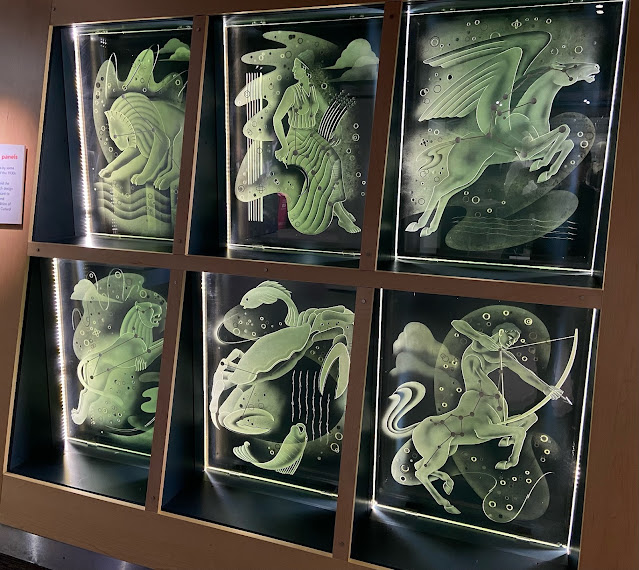 |
| Decorative glass panels from the Cabin (first) Class Dining Room aboard the second RMS Mauretania, launched in 1938 as one of the first ships built for the newly-merged Cunard-White Star Line. The design of each panel was based on a constellation significant to either the first or second Mauretania. The second Mauretania featured decorations by some of the most influential designers of the 1930s in an attempt by Cunard-White Star to promote the tradition of decorative excellence aboard passenger liners. |
 |
| A display of tableware used aboard various ships operated by some of the many Liverpool-based shipping companies. The collection reflects the changing styles over time and the different uses, whether on board an emigrant ship, a passenger liner, or a cargo vessel. Dining at sea has been central to the passenger experience, with shipping companies understanding that quality of food and drink is critical to a successful voyage. Crockery used on early passenger vessels was functional and durable, capable of withstanding rough weather and repeated use. In time, the shipping companies adopted prestigious bone china for their First Class services, featuring increasingly intricate and decorative designs. Impressive table settings were a way of creating an immediate impression as passengers sat down to dine. |
 |
| A Bertoia side chair from the Cunard liner Queen Elizabeth 2. Designed in 1952 by Harry Bertoia, these wire chairs were among the novel 1960s furnishings which Cunard adopted for QE2 in an effort to make the ship stylish and futuristic. In its competition with air travel, Cunard sought to lead the passenger shipping industry into a new era with its slogan, 'Ships have been boring long enough.' Bertoia's side chairs, used in QE2's public spaces, soon proved to be impractical and many were replaced. |
 |
| A series of dioramas depict a day in the life of Gertrude Walker aboard ship. Born in 1884, Walker and her husband Walter and two daughters relocated to Chile for Walter's work. Feeling isolated and homesick, Gertrude and her daughters returned to Britain after Gertrude's mother died. She delayed her return to Chile, only returning under pressure from Walter. Over 50 years, Gertrude and her daughters sailed back and forth between Britain and South America numerous times, becoming seasoned travellers and enjoying life aboard these ocean cruises. Gertrude Walker returned to Britain permanently in 1961, her last voyage across the Atlantic being aboard the Reina del Mar. This first diorama depicts Gertrude Walker's cabin during the first morning aboard ship, when she spent her time unpacking and settling in, assisted by a stewardess. Items displayed here include a travelling trunk; a make-up/jewellery box; a silver inkwell from RMS Cedric, circa 1903; seasickness tablets; a vomit can; a chamber pot; black suede sandals; a silk kimono dressing gown, circa 1930s-1940s; and a compactum (washing stand) with water reservoirs and drop-leaf basin. |
 |
| This diorama depicts Gertrude Walker's afternoons at sea, spent relaxing on deck and taking afternoon tea. Items displayed here include an early 20th century White Star Line woollen steamer blanket; a deckchair from the Allan Line; a parasol used by Gertrude Walker during her travels; a 1920s-1930s White Star Line tea set made by Stonier and Co. Ltd.; a floral summer dress and beaded necklace worn by Gertrude Walker or her daughters; and a lifebelt from the Cunard liner RMS Mauretania (1906). |
 |
| Gertrude Walker enjoyed pre-dinner drinks and conversation in the ship's cocktail bar in the evenings. Items displayed in this diorama include a decorative glass panel from Cunard's RMS Lucania (1893); an Art Deco table lamp from RMS Mauretania II (1938), the largest transatlantic liner built on the River Mersey; a 1930s Art Deco ashtray; crystal glassware from RMS Queen Mary dating from the 1940s and 1950s; a Cunard saloon chair from circa 1890; a deck plan for Canadian Pacific Steamship Line's Empress of Canada II (1940s); a steward's jacket; and Gertrude Walker's ball gown, velvet bag, and jewellery. |
 |
| A selection of the Merseyside Maritime Museum's collection of paintings of passenger vessels through the decades, displayed in the 'Life on Board' gallery. Many artists have been inspired by the romance of the open ocean and exotic ports of call to create varied interpretations of passenger ships and life on board. |
 |
| A painting by Isaac Joseph Witham showing the SS Sarmatian departing the Mersey for Canada, with Her Royal Highness Princess Louise and the Marquis of Lorne aboard, 14 November 1878. Built in 1871, Sarmatian was owned by the Allan Line, also known as the Montreal Ocean Steamship Company, based in Liverpool. The company was under contract with the Government of Canada to carry passengers and mail between Great Britain, Canada, and the United States. John Campbell, the 9th Duke of Argyll, served as the fourth Governor General of Canada from November 1878 to October 1883. |
 |
| A painting of SS Celtic in the Mersey by Parker Greenwood. Celtic was built for the White Star Line by Harland & Wolff of Belfast in 1872 and was scrapped in Brest, France in 1898. |
 |
| John Stobart's painting of the liner MV Aureol at sea at night, as seen from the liner Accra. The 14,083 gross ton Aureol was built in Glasgow in 1951 for the Liverpool-based Elder Dempster Lines and spent her entire career operating on the UK-Lagos, Nigeria route. Accra, another Elder Dempster liner, was launched in 1947 and also served West African ports. |
 |
| Another painting of MV Aureol by John Stobart, depicting the ship on the River Mersey in Liverpool. Aureol carried up to 329 passengers and 145 crew and sailed from Liverpool between 1951 and 1972, when her port of departure shifted to Southampton. Retired in October 1974, Aureol was purchased by a Greek oil tycoon and renamed Marianna VI. Laid up in Eleusina, Greece in 1989, the ship did not sail again until 2001, when she travelled to Alang, India for scrapping. |
 |
| A painting of the Voltaire by Walter Thomas. Launched in 1923 for the Lamport & Holt shipping company, Voltaire carried passengers and mail between Great Britain, New York, and South America. After serving as a troopship and then an accommodation vessel in the early part of the Second World War, Voltaire was converted into an armed merchant cruiser and commissioned as HMS Voltaire. On 4 April 1941, HMS Voltaire was sunk by the German commerce raider Thor off the coast of West Africa. Seventy-six of Voltaire's crew died, with 189 survivors taken prisoner aboard Thor. |
 |
| A painting of SS Hilary by Norman Wilkinson. The 7,403 gross ton Hilary was built for the Booth Steamship Company by Cammell, Laird & Company in 1931 and spent much of her career on the Liverpool to Manaus, Brazil route. She carried up to 80 First Class and 250 Third Class passengers. From 1940 to 1942, Hilary was commissioned into the Royal Navy as HMS Hilary and served as an ocean boarding vessel. Returned to commercial service in 1942, Hilary was re-commissioned in 1943 to serve as an infantry landing ship (headquarters), carrying six landing craft and berths for 313 crew and 378 troops. After the war, Hilary resumed commercial service between Liverpool and Brazil until being retired and scrapped in 1959. |
 |
| A 1940 poster by the Pacific Steam Navigation Company depicting the attractive sights for passengers taking the 'sunshine tour' of South American destinations aboard the MV Reina del Pacifico. At 17,707 gross tons, the Reina del Pacifico was built in 1930-31 and sailed between Liverpool and the Pacific coast of South America until 1939. For several years, Reina del Pacifico was the largest ship operating scheduled services to the Pacific coast of South America, carrying 880 passengers in three classes and lavishly decorated in Moresque and Spanish Colonial styles. Serving as a troop ship during the Second World War, Reina del Pacifico returned to commercial service in 1948 and was scrapped in 1958. |
 |
| A poster by Yeoward Line, circa 1920, advertising the line's three-week holiday cruises to Portugal, Madeira, and the Canary Islands. In the early 1900s, Yeoward Line began as fruit suppliers, adapting its ships to carry bananas from the Canary Islands. Soon thereafter, the line began carrying First Class passengers between Liverpool and mainland Spain, Portugal, and the Canary Islands. The Yeoward Line ceased operations in 1954. |
 |
| The entrance to the 'Titanic & Liverpool: The untold story' gallery, which tells the story of the Liverpool-based White Star Line and its most famous ship, RMS Titanic, as well as the links between Titanic and the people of Liverpool. |
 |
| The first section of the gallery traces the rise of Liverpool as one of the world's greatest seaports and a major centre for world shipping and trade by the early 20th century. As the home of the White Star Line and many other shipping companies, Liverpool was the main departure point for passengers travelling to North America. |
 |
| An oil on canvas by Max Sinclair, entitled 'In the Mersey'. This 1889 painting depicts the busy River Mersey when Liverpool was at the height of its influence as a port. The large liner in the centre is City of New York, owned by the Inman Lines and one of the largest and fastest ships in the world at that time. City of New York and Titanic nearly collided in 1912 as Titanic departed Southampton on her maiden voyage. A painter of land and seascapes in oil and watercolour, Max Sinclair produced several works depicting the Mersey. |
 |
| A highly detailed oil on canvas portrayal of Liverpool by Walter Richards, entitled Modern Liverpool, 1907. The painting depicts the city's busy waterfront in its 700th anniversary year, with the White Star Line building and Liverpool's overhead railway clearly visible. The Liver Building is also depicted, though it had not yet been built in 1907. A Cunard ship, either Lusitania or Mauretania, is shown at the landing stage on the Mersey. Cunard's liners prompted White Star to build the Olympic and Titanic to compete for the transatlantic passenger trade. The artist Walter Richards was based in Liverpool and regularly exhibited works, including this one, at the Walker Art Gallery. |
 |
| At the centre of the first room of the gallery are display cases containing the Ismay testimonial silver. This part-gilded dinner service was presented to White Star Line owner Thomas Henry Ismay (1837-1899) by appreciative shareholders in 1885 aboard the liner Adriatic in Liverpool. |
 |
| Designed by artist G.A. Carter and manufactured by the London silversmiths Hunt & Roskell, the Ismay silver service illustrates progress in the art of navigation from earliest times to the late 19th century. The grand centrepiece represents 'Commerce on top of the World'. The set also includes oval flower stands, navette-shaped and circular dessert stands, silver goblets, sugar vases with ladles, water jugs, candelabras, and various salt cellars resembling coracles, Greenland kayaks, Canadian birch canoes, Fiji islands canoes, Egyptian boats, and New Zealand canoes. |
 |
| A display recounting the creation of International Mercantile Marine (IMM) by American millionaire John Pierpont Morgan, which eventually purchased White Star Line in 1902. The cabinet also contains a number of items manufactured by the wide range of companies across Britain, including in the Liverpool area, that supplied Belfast's Harland & Wolff shipyard, at which the Olympic class liners were built. The items include an elegant china demitasse cup and saucer made exclusively for Titanic by the famous Spode pottery in Stoke-on-Trent in 1911, and casting patterns for porthole covers and the main ship's bells on Olympic and Titanic. On the right are samples of IMM tableware, including a tea cup and saucer (Buffalo Pottery, USA, 1925); a dinner plate (Rosenthal, Germany, c. 1923); an egg cup (maker unknown, 1902); and a large water jug (Doulton, UK, 1902). |
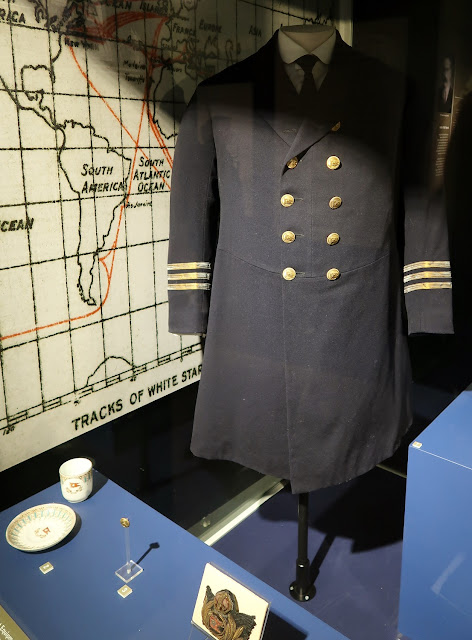 |
| A display case containing White Star Line artefacts, most notably a Chief Officer's uniform frock coat worn by William Lightfoot of Liverpool, circa 1900; Titanic's officers wore similar frock coats. Other items here include a First Class coffee cup and saucer (c. 1903-07) made by Stonier & Co. Ltd. of Liverpool and identical to the tableware pattern used aboard Titanic; a White Star Line uniform button; and a White Star Line cap badge. |
 |
| A White Star Line poster from 1912, by Montague B. Black. Produced by the Liverpool Printing & Stationary Company, the poster was published the same year that Titanic made her ill-fated maiden voyage. It is believed that Montague Black was primarily an illustrator and poster artist rather than a maritime painter, though he was responsible for many of White Star Line's impressive posters. |
 |
| A large 1:48 scale builder's model of RMS Titanic. Built in 1910 by the Harland & Wolff shipyard in Belfast at the same time as the liner itself, the model originally depicted first of class RMS Olympic and was used by the White Star Line to advertise the ship. The detailed model was even originally fitted with internal lighting. After the tragic loss of Titanic, the model was altered to depict sistership RMS Britannic, the third ship of the Olympic class of liners. The most notable alteration was the rearrangement of the windows on the upper deck. As Britannic was sunk by a mine on 21 November 1916 while serving as a hospital ship during the First World War, the model was altered again in the 1920s to depict the refitted sole survivor of the class, RMS Olympic. The effect of the various changes made to the model means that it now more closely resembles Titanic than either of her sisterships. After being displayed at Blackpool's Winter Gardens, the model was gifted to National Museums Liverpool in 1951. |
 |
| Visitors seated in period theatre seating view historic newsreel footage of the Titanic disaster and the rescue effort. |
 |
| A ceramic sink, a chamber pot, and a ventilation grille salvaged from the debris field on the seabed around the wreck of Titanic. They were given to the Liverpool and London Steamship Protection and Indemnity Association, which had settled claims for compensation for loss of property by some of Titanic's passengers. The Association was set up by White Star Line owner Thomas Ismay (1837-1899) in 1881 and was based in Liverpool until June 2016; it was dissolved in September 2018. |
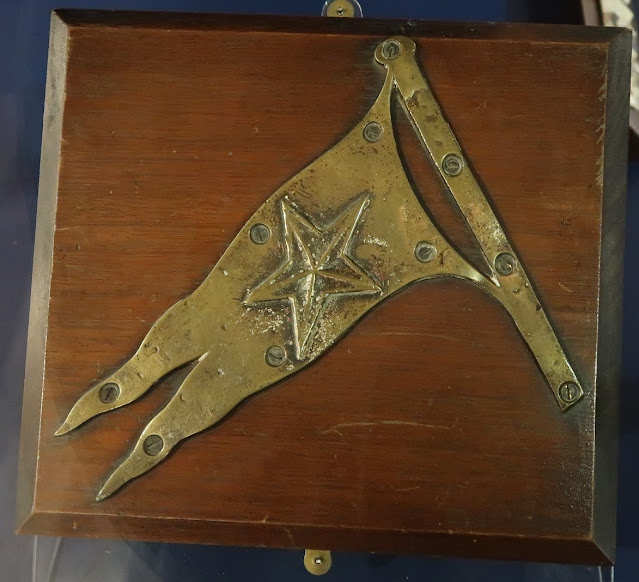 |
| A brass White Star Line flag emblem from a Titanic lifeboat. The metal houseflag (burgee) emblem was one of two kept as mementos by A. Morgan, a seaman aboard Carpathia, one of the ships that responded to Titanic's distress calls. They were subsequently mounted on wooden backboards for display. Originally, the emblems were painted in red and white, though the paint has worn away, exposing the brass underneath. |
 |
| More items salvaged from the wreck of Titanic: A hollow ceremic dish and cup featuring the White Star Line logo; a jewellery case; tie pins, including one made of gold; pince-nez glasses; a wrist watch; a letter opener; a bottle; and a cut crystal carafe. |
 |
| A life jacket worn by a Titanic survivor in Lifeboat No. 9. Made from cork with a canvas covering, two of the four ties are cut off short. It is believed that these ties were fastened around the front with bows and that the jacket was removed by cutting the ties under the armpits. The life jacket was retained by Ernest St Clair (1893-1982), a 19-year old waiter on Carpathia. |
 |
| The ship's bell from the third MV Britannic, the last ship to sail under the White Star's colours and fly the company's flag. Built by Belfast's Harland & Wolff shipyard and launched in 1930, the 26,943 gross ton Britannic and sistership Georgic were the last ships built for the White Star Line. Britannic retained the company's colour scheme of buff-coloured funnels even after the merger of White Star and its competitor Cunard in 1934. The buff funnel colours finally disappeared when Britannic was withdrawn from service in December 1960. Britannic was scrapped by the end of 1961. |
 |
| The MV Edmund Gardner, a former pilot cutter, is displayed in the Canning No. 1 graving dock opposite the museum. Ordered by the Mersey Docks and Harbour Board and built by Philip & Sons Ltd. of Dartmouth, Devon, Edmund Gardner was the second of three steel-hulled, diesel-electric cutters and was launched on 9 July 1953. Named after the chairman of the Mersey Docks and Harbour Board in 1948-50, the cutter entered service on 2 December 1953 and was used to ferry harbour pilots to and from ships entering and leaving the Mersey. Although the pilots would ordinarily use wooden motor punts to transfer between the cutter and the ships, in extreme weather the cutter itself would lead ships in and out of the harbour. With the development of large container ships, fewer vessels visited the Mersey ports and it became more efficient to send pilots out to the vessels directly from shore in high-speed launches rather than having them waiting at sea in the pilot cutters. Edmund Gardner was thus retired from service in April 1981 and purchased by the Merseyside Maritime Museum in 1982. She remains in her original condition upon retirement and is a member of the National Historic Fleet. |
 |
| Edmund Gardner and her two sisters carried up to 32 pilots and 11 apprentice pilots in addition to her regular crew of 11. The cutters typically worked one week on station at the Mersey bar, one week off Point Lynas in Anglesey, and one week serving as the supply boat and tender for the boats on station. With strong currents, shifting sandbanks, rocks, dangerous weather, and two daily tides with an 11 metre (36 foot) variation, the Mersey required knowledgeable pilots to help visiting ships safely navigate in and out of port. The 701 gross ton Edmund Gardner measures 54.1 metres (177.38 feet) in length, with a beam of 9.68 metres (31.74 feet), and a draught of 3.10 metres (10.16 feet). Her two six-cylinder 640-horsepower diesel engines generated power for the electric motor that drove the ship at a maximum speed of 14 knots (26 km/h, 16 mph). Edmund Gardner carried two 5.8 metre (19 foot) motor launches to ferry pilots between the cutter and incoming and outgoing merchant ships, as well as two 8.2 metre (27 foot) oared lifeboats. |
 |
| Displayed next to the Canning Dock opposite the Merseyside Maritime Museum is one of the four four-bladed propellers from the Royal Mail Ship (RMS) Lusitania. The 31,550 ton passenger steamship was built on the River Clyde in Scotland for the Liverpool-based Cunard Line between 1904 and 1906. Lusitania's original three-bladed propellers were replaced in 1909 by four-bladed propellers in order to improve the ship's speed. On 11 October 1907, the ship briefly captured the record for the fastest crossing of the Atlantic by a passenger vessel, making the passage in four days, 19 hours, and 53 minutes. On 7 May 1915, during an eastbound voyage from New York to Liverpool, Lusitania was torpedoed by the German submarine U-20 and sank in less than 20 minutes off the south coast of Ireland. Of the 1,960 passengers and crew aboard, 1,193 died in the sinking, with 767 survivors, of which four died later from their injuries. The deliberate targeting of an unarmed passenger liner provoked outrage, while the deaths of 128 American passengers aboard Lusitania contributed to the US declaration of war against Germany in April 1917. Three of the Lusitania's propellers, including this one, were salvaged in 1982 for display. A commemorative ceremony is held next to the propeller each year to mark the anniversary of the sinking. |
 |
| The Motor Tug (MT) Brocklebank, built by WJ Yarwood & Sons of Northwich, Cheshire in 1964-65. A steel-hulled coastal/harbour tug, the 172 ton Brocklebank measures 31.4 metres (103 feet) in length, with a beam of 8.2 metres (27 feet) and a draught of 4 metres (13.2 feet). Her 8-cylinder, 1,200-horsepower Crossley turbo-charged diesel engine provides a top speed of 12.5 knots (23.2 km/h, 14.4 mph). Brocklebank's 'bollard pull', a measurement of pulling power from a stationary position using maximum engine power, is 18 tons. |
 |
| Brocklebank was one of five motor tugs built by WJ Yarwood & Sons between 1962 and 1965 for Alexandra Towing Company Ltd. of Liverpool. Principally used for ship handling at Liverpool, Brocklebank also saw occasional service at Heysham, Larne, and Barrow. She towed barges loaded with stone from the Dinmor Quarry in Anglesey for use in building the Royal Seaforth Docks in Liverpool. Brocklebank was purchased by the Merseyside Maritime Museum in 1989 and is operated by experienced mariners on behalf of the Friends of the National Museums Liverpool. The tug has had the honour of escorting the Royal Yacht Britannia, carrying Queen Elizabeth II and Prince Philip into Liverpool during a visit in August 1988, as well as serving as the start and finish vessel for the around the world clipper yacht race. Brocklebank's usual berth is here, alongside the museum, though the tug also participates in maritime festivals at various UK coastal towns. |
 |
| The Merseyside Maritime Museum illuminated at night. |































.JPEG)










































































































